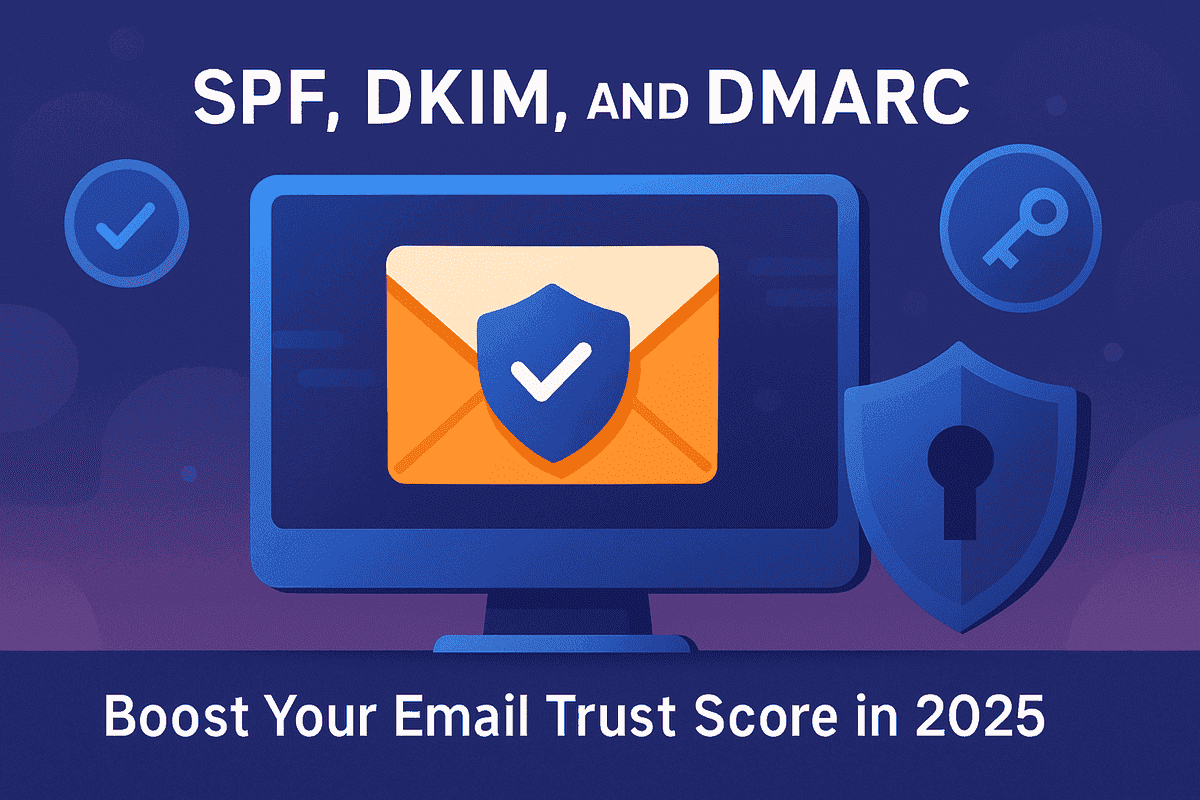Why Your Emails Aren't Getting Delivered (And What to Do About It)
"Why do my emails go into spam?"
That's the lament of millions of business owners each day. You spend hours writing flawless messages—only to discover no one ever received them.
These days in the inbox warzone, spam filters are more stringent than ever. Guilty party? Subpar email authentication.
Let me pose a question to you:
- Do you have a custom domain for emails?
- Have you ever observed low open or click-through rates?
- Are Gmail or Outlook marking your emails as "suspicious"?
If you answered "yes" to either of those, it's time to increase your Email Trust Score—starting with SPF, DKIM, and DMARC.
What Are SPF, DKIM, and DMARC? (Plain English Definitions)
SPF (Sender Policy Framework)
SPF is a guest list. It instructs mail servers who can send on your domain's behalf.
- Blocks domain spoofing
- Stops spammers from faking your identity
- Reduces chances of ending up in spam
Think of it as telling Gmail: "Only these servers can speak for me."
DKIM (DomainKeys Identified Mail)
DKIM adds a digital signature to your email. It proves the message wasn't tampered with in transit.
- Verifies the content wasn't altered
- Builds sender reputation
- Adds cryptographic proof to your email header
Like signing your letter with a secure wax seal.
DMARC (Domain-based Message Authentication, Reporting & Conformance)
DMARC brings it all home. It instructs ISPs what to do when SPF/DKIM don't work (quarantine, reject, or permit).
- Provides you complete visibility in reports
- Assists in combating phishing and impersonation
- Preserves brand trust and customer security
It's your gatekeeper—and your snitch.
Why These Protocols Matter in 2025 More Than Ever
Email security threats have never been higher.
2025 has witnessed a 34% rise in phishing attacks on SMBs.
Search engines and inbox providers are cracking down. Big players such as Gmail, Yahoo, and Outlook now favor authenticated domains for inbox delivery.
For small businesses, that means:
- Improved email deliverability
- More trust with customers
- Improved engagement and conversion rates
Not using SPF/DKIM/DMARC is tantamount to giving the cybercriminals your brand on a silver platter.
Step-by-Step Setup: How to Set Up SPF, DKIM, and DMARC
Create Your SPF Record
- Log in to your DNS settings
- Add a TXT record such as:
v=spf1 include:your-email-provider.com ~all
- Validate using tools such as MXToolbox or Google Admin Toolbox
Install DKIM
- Refer to your email provider documentation (Gmail, Outlook, etc.)
- Create a DKIM key pair
- Publish the public key as a TXT record in your DNS
- Turn on DKIM signing in your admin interface
Set Up DMARC
- Create a TXT record in DNS:
v=DMARC1; p=quarantine; rua=mailto:you@yourdomain.com;
- Select policy: none, quarantine, reject
- Keep an eye on reports weekly for attempts at spoofing
Pro Tip: Begin with p=none and get data before enforcing.
Real-World Case: How One SMB DUBLED Open Rates With Email Authentication
Before:
An eCommerce startup in San Diego observed 48% of their emails were being ignored. Most were quietly dropped or marked as spam.
After Adding SPF, DKIM & DMARC:
Deliverability increased to 94%
Open rates grew by 2x
Spam complaints fell to zero
They didn't alter their email copy. Just their authentication configuration.
Pitfalls to Avoid With SPF, DKIM, and DMARC
- Utilizing more than one SPF record (just one per domain is permitted)
- Not updating DNS when changing email providers
- Implementing DMARC before reviewing reports
- Subdomain policies being ignored
- Failing to notice alignment problems between SPF/DKIM headers
Steer clear of these, and your emails will zip straight into inboxes—not spam.
Best Practices to Keep Your Email Domain Trusted
- Employ professional email services with integrated authentication
- Review DMARC reports frequently (utilize tools such as Postmark or Dmarcian)
- Change DKIM keys every 6-12 months for security
- Set "From" and "Return-Path" headers the same
- Train your team about phishing methods
Being proactive keeps your domain out of blacklists and earns you long-term trust with both ISPs and users.
FAQs
Q: Do I have to use all three—SPF, DKIM, and DMARC?
Yes. Each does something specific. Together, they are an effective email authentication system.
Q: How long does implementation take?
Less than an hour for the majority of domains. Some email providers do it for you.
Q: Can I test my setup using free tools?
Yes. MXToolbox, Google Admin Toolbox, and Mail Tester are good options to try.
Q: Will this improve Gmail promotions tab?
It can help with placement, but tab filtering is also subject to content and engagement.
Q: Is DMARC too sophisticated for small business?
No way. Begin with a monitoring policy (p=none) and expand from there.
Conclusion: Own Your Email Reputation
Your email domain is your online identity. Would you give it to a stranger? That's what happens when you bypass SPF, DKIM, and DMARC.
In 2025, email trust isn't a nicety—it's a requirement. And the best news? It's entirely within your power.
Start small. Lock down your domain. See your email metrics rise.
Safe emails = loyal customers.

